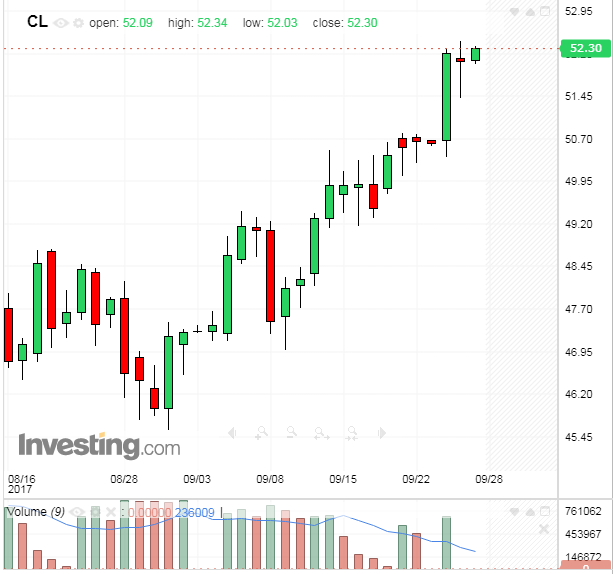During the first 25 days of September, Brent crude prices rose 12.7% to $59.02 per barrel. After almost three years of depressed prices and a summer in which Brent bottomed as low at $44.82 per barrel, there is talk that this jump is the start of a significant price rebound. It is important to understand what elements in the market may have contributed to this jump in the last three to four weeks.
1) Kurdish Independence Referendum
For the last few weeks, fear of instability in the Middle East has grown as the date of the Kurdistan Regional Government’s (KRG) 25 September referendum on Kurdish independence drew closer. This past Monday, Turkish President Recip Tayyip Erdogan threatened to cut off the Ceyhan pipeline, which brings about 550,000 barrels a day of oil from the KRG region to a port in Turkey. Though at the time of writing Turkey has not acted on this threat, Erdogan has reiterated his commitment to “close the tap,” on Kurdish oil in retribution for this referendum.
The fear of overall instability and particularly a drop in supply from Kurdish-held regions has caused oil prices to climb higher. No one knows what instability may occur or how the geopolitical issues will resolve. While Turkey, Iran and Iraq are all disgruntled about the referendum vote, and have all threatened the KRG, the KRG has a strong case for sovereignty based on its well-tested military, control of the territory, existing economy, and control of water flowing from the Tigris River.
2) OPEC / Non-OPEC Production Cut Deal
The OPEC and non-OPEC monitoring committee met in Vienna on 22 September and announced that the global oil glut is “halfway” cleared. At the same time, the committee did not make any recommendations about whether the production cuts should be extended past their March 2018, expiration date. Russian oil minister Alexander Novak mentioned the possibility of “a gradual, slow exit strategy,” that the group may implement at some point during the latter half of 2018. Novak indicated that Russia would be open to deciding whether or not to extend the production cuts in January. The committee also discussed production caps for OPEC members Libya and Nigeria, whose unfettered production has caused price drops. Although no commitments were made, the indication is that some commitment from Libya and Nigeria to make production cuts will be forthcoming.
Unlike last May, when the market dropped after OPEC announced an extension of the production cuts but no further cuts, the market saw this announcement about a “halfway” cleared glut and the openings for continued and further cuts as positive signs and oil prices rallied.

3) Inventory Projections
Recent projections from oil trading group Trafigura and the IEA foresee an oil shortage as soon as 2019 or 2020. Citigroup echoed this sentiment, explaining that it believes several key OPEC producers (Libya, Nigeria, Venezuela, Iraq and Iran) are currently pumping at their maximum capacities. Therefore, Citigroup believes the market should not fear a sudden increase in production from any of these producers in the near future.
These projections are another reason oil prices have risen of late. They are all very good news for those seeking higher oil prices. The question will be whether projections in the coming months coincide with these. As well, there are many other producers that could increase production if the opportunity arises (and higher prices represent such an opportunity).
4) Momentum
Trading momentum is a significant aspect of this recent jump. Recent narratives from prominent news sources have described the market as shifting from bearish to bullish. These declarations are also self-fulfilling prophecies, as they create an expectation that oil prices will continue to rise. With continued news or conjecture about supply disruptions, OPEC cuts, or future shortages, the momentum could continue. To some extent, the perpetuation of upward momentum depends most on what the traders and speculators feel. It could take oil higher, but today few are predicting this to lead directly to the $70+ range.
